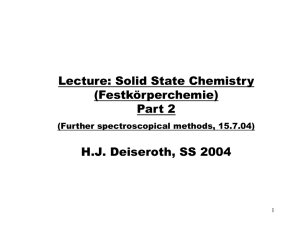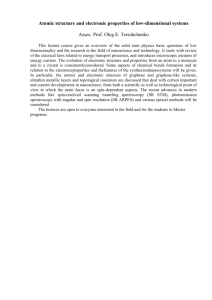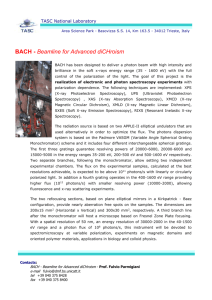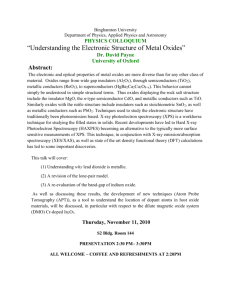Lecture: Solid State Chemistry H.J. Deiseroth, SS 2006 (Further spectroscopical methods, 8.6.06)
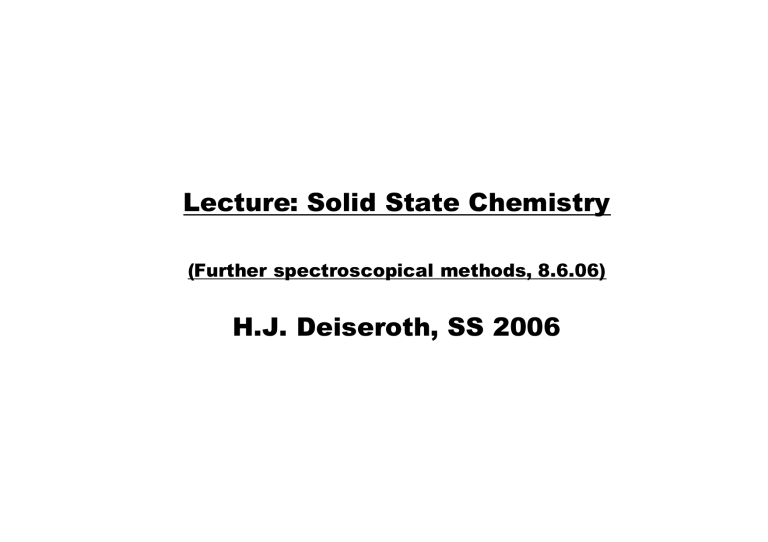
Lecture: Solid State Chemistry
(Further spectroscopical methods, 8.6.06)
H.J. Deiseroth, SS 2006
Orders of magnitude in energy
spectroscopic techniques
ESCA: Photoemission or Photoelectron spectroscopy
ESCA = Electron Spectroscopy for Chemical Analysis
Basic equation: E out
= h - E bind .
Int.
h
UV or
X-Ray h UHV solid
E bind.
e
-
(E out
)
E strong
E bind.
- the higher the binding energy
(E bind.
) the lower the E out
!
- ESCA is in particular a surface sensitive method (UHV !)
ESCA: Photoemission or Photoelectron spectroscopy
ESCA: Photoemission or Photoelectron Spectroscopy
Exciting Radiation Outcoming Radiation
UV (~ 20 eV) UPS
X-Ray (~ 10 keV) XPS electrons from occupied valence states electrons from
(occupied) core states
-commercial laboratory based spectrometers (UHV-technique) are available but relatively expensive and of limited versatility !
- more promising for the future is the use of synchroton radiation:
continuous spectrum of exciting radiation (UV X-Ray)
- intensity of synchroton radiation is orders of magnitudes higher !
(e.g. angle resolved detection of outcoming radiation is possible
- detection of „orbital shapes“)
- polarization of synchroton radiation allows spin polarized experiments
ESCA: Photoemission or Photoelectron spectroscopy
- analysis of the energy levels of electrons in molecules („chemical shift“)
- band structure of solids
S
2
O
3
2-
KCr
3
O
8
E bind.
E out
E bind.
E out
Synchroton Storage Ring
EXAFS and XANES
Spectroscopical methods associated with specific physical effects at/near characteristical X-ray absorption edges:
EXAFS: Extended X-Ray Absorption Fine Structure
XANES: X-Ray Absorption Near Edge Structure
- tunable synchroton radiation in the X-Ray region necessary
Moessbauer Spectroscopy
the nucleus of the specific isotope of an atom embdedded in a solid (e.g.
57 Fe) is excited by instable isotope of a neighbor element (e.g.
57 Co)
„Chemical shift“ and „Hyperfine splitting“ source: e.g.
57 Co
(tunable)
Doppler effect absorber: e.g.
57 Fe frequently applied for
57 Fe, 119 Sn, 127 J
...
chemical surrounding (symmetry, coordination number, oxidation state, magnetism) of atoms with these nuclei in a solid can be probed in a highly sensitive way (~10 -8 eV)
Moessbauer Spectroscopy
Two major informations from
Moessbauer spectra: a) „Chemical Shift“
(not to be confused with the same term in NMR and ESCA)
oxidation state b) Hyperfine Splitting
magnetic interactions
